The U.S.-Dakota War of 1862 that raged through southwestern Minnesota was the result of failed U.S. government Indian policies, and it continues to the lives of many communities to this day.
Uncover the places and stories that changed the course of history along the Minnesota River Valley.
Listen to stories and reflections about historic sites
Listen from any location — from the byway, from home, from anywhere. Smart phone users can access the mobile-friendly tour site. Basic phone users can call 888-601-3010 and press the * key at any time to return to the menu and select another stop.
Learn about the people who lived there and the lasting impact of the U.S.-Dakota War of 1862.
Download the Travel Guide (PDF) to discover more about historic sites related to the war.
Introduction
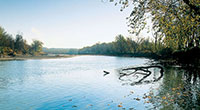
Listen to Related Stories and Reflections
 Bdote — One Origin Story
Bdote — One Origin Story Settlers who Moved onto Dakota Land
Settlers who Moved onto Dakota Land How events Surrounding the U.S.-Dakota War Resonate with the Dakota Today
How events Surrounding the U.S.-Dakota War Resonate with the Dakota Today Shadow’s of Voices, a Poem by Gabrielle Tateyuskanskan
Shadow’s of Voices, a Poem by Gabrielle Tateyuskanskan
Traverse des Sioux  Minnesota Historical Society Site
Minnesota Historical Society Site
St. Peter • 507-934-2160 • mnhs.org/traversedessioux

This Minnesota River crossing is the site of the 1851 U.S.-Dakota land treaty, where you can walk trails and view exhibits on the treaty, the Dakota, and the fur trade. Located within Traverse Des Sioux Park and managed by Nicollet County Historical Society.
Listen to Related Stories and Reflections
 Traverse des Sioux
Traverse des Sioux Perspectives on the Treaty Signings of 1851 and 1858
Perspectives on the Treaty Signings of 1851 and 1858 The Impact Treaties have on the Dakota Nation
The Impact Treaties have on the Dakota Nation
Map • Additional Resources • More Information (PDF)
New Ulm, Minnesota
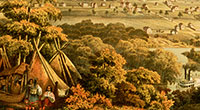
Listen to Related Stories and Reflections
 New Ulm
New Ulm Descriptions of European Immigrant Life on the Prairie
Descriptions of European Immigrant Life on the Prairie Reflections on the Legacy of 1862 left on the People of New Ulm
Reflections on the Legacy of 1862 left on the People of New Ulm
Map • Additional Resources • More Information (PDF)
Lower Sioux Agency  Minnesota Historical Society Site
Minnesota Historical Society Site
Morton • 507-697-6231 • mnhs.org/lowersioux
 The U.S.-Dakota War of 1862's first attack took place here. Exhibits help you understand Dakota life and culture, and the war's underlying causes. Managed by Lower Sioux Indian Community.
The U.S.-Dakota War of 1862's first attack took place here. Exhibits help you understand Dakota life and culture, and the war's underlying causes. Managed by Lower Sioux Indian Community.
Listen to Related Stories and Reflections
 Lower Sioux Agency
Lower Sioux Agency How the U.S. Dakota War Impacted the People and Land
How the U.S. Dakota War Impacted the People and Land Stories and Reflections about Land and Home before the War
Stories and Reflections about Land and Home before the War
Map • Additional Resources • More Information (PDF)
Stop #5: Birch Coulee Battlefield  Minnesota Historical Society Site
Minnesota Historical Society Site
Morton • 800-657-3773 • mnhs.org/birchcoulee
 One of the hardest-fought battles in the U.S.-Dakota War of 1962 happened here. Guideposts pinpoint the U.S. and Dakota positions, and interpretive markers provide historical accounts and viewpoints.
One of the hardest-fought battles in the U.S.-Dakota War of 1962 happened here. Guideposts pinpoint the U.S. and Dakota positions, and interpretive markers provide historical accounts and viewpoints.
Listen to Related Stories and Reflections
 Birch Coulee
Birch Coulee Dakota Spiritual Connection with the Land
Dakota Spiritual Connection with the Land Reflecting back on the Dakota people’s fight for Survival
Reflecting back on the Dakota people’s fight for Survival
Map • Additional Resources • More Information (PDF)
Stop #6: Upper Sioux Agency

Located within Upper Sioux Agency State Park.
Listen to Related Stories and Reflections
Map • Additional Resources • More Information (PDF)
Stop #7: Camp Release
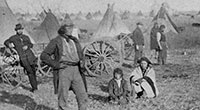
Located within Camp Release State Park.
Listen to Related Stories and Reflections
 Camp Release
Camp Release The Story of Mazasa and his attempt at a Peaceful Resolution
The Story of Mazasa and his attempt at a Peaceful Resolution Mounting Tensions within the Dakota Community leading up to the time of the U.S.-Dakota War
Mounting Tensions within the Dakota Community leading up to the time of the U.S.-Dakota War
Map • Additional Resources • More Information (PDF)
Stop #8: Fort Renville

Located within Lac qui Parle State Park.
Listen to Related Stories and Reflections
 Fort Renville
Fort Renville Dakota Lifeways that existed in Minnesota before European Contact
Dakota Lifeways that existed in Minnesota before European Contact Dakota Connection to water, both Physically and Spiritually
Dakota Connection to water, both Physically and Spiritually How Life Changed for the Dakota with the Arrival of the Fur Trade
How Life Changed for the Dakota with the Arrival of the Fur Trade
Map • Additional Resources • More Information (PDF)
Stop #9: Lac qui Parle Mission  Minnesota Historical Society Site
Minnesota Historical Society Site
Montevideo • 320-269-7636 • mnhs.org/lacquiparle
 The first Dakota-language dictionary, grammar and gospel were completed at this mission, founded in 1835. Located within Lac qui Parle State Park and managed by Chippewa County Historical Society.
The first Dakota-language dictionary, grammar and gospel were completed at this mission, founded in 1835. Located within Lac qui Parle State Park and managed by Chippewa County Historical Society.
Listen to Related Stories and Reflections
Map • Additional Resources • More Information (PDF)
Stop #10: Wabasa Village
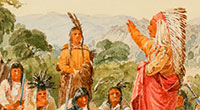
Listen to Related Stories and Reflections
Map • Additional Resources • More Information (PDF)
Stop #11: Fort Ridgely  Minnesota Historical Society Site
Minnesota Historical Society Site
Fairfax • 507-508-2848 • mnhs.org/fortridgely
 Exhibits and ground markers tell the tale of this 1853 military outpost, which saw combat during the U.S.-Dakota War of 1862. Located within Fort Ridgely State Park and managed by Nicollet County Historical Society.
Exhibits and ground markers tell the tale of this 1853 military outpost, which saw combat during the U.S.-Dakota War of 1862. Located within Fort Ridgely State Park and managed by Nicollet County Historical Society.
Listen to Related Stories and Reflections
Map • Additional Resources • More Information (PDF)
Stop #12: Henderson
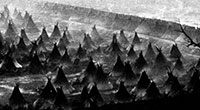
Listen to Related Stories and Reflections
Map • Additional Resources • More Information (PDF)
Stop #13: Mankato
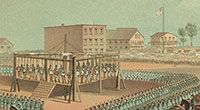
Listen to Related Stories and Reflections
The tour is funded by a grant from the National Scenic Byways Discretionary Grants Program administered by the Federal Highway Administration.




